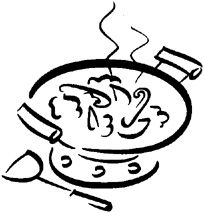
MAKES 25 TO 30 SPRINGROLLS
This very special springroll was the brainchild of one of my favorite sous-chefs, Mindy Schreil (aka Arminda Raymundo Asprer Schreil), who remembered something like them from her Philippine childhood. Mindy served them at her wedding, and you might do the same at yours. They are a big deal and a bit of a hassle, as befits a wedding, but the result is worth the effort. The hint of honey is appropriate to any sweet occasion.
Preparations may be completed well in advance, but to be perfect the springrolls should be fried last-minute.


Thick shreds of our Chinese-style duck confit (page 170) would be great in these springrolls, if you have some on hand and want to save yourself the first 2 steps.

I am well known for a certain daffy precision, but instructing people to stir things in one direction seems like an infringement on human liberty. All true, but I did my initial culinary reading in Chinese, and there the briefly delineated steps for stirring meat mixes, fish purées, and the like always specified to stir in one direction. In the bowl, it has a happy logic: Minced meat mixtures, for example, compact less and blend more evenly when the hand stirs one way instead of back and forth.
Virgo madness knows few bounds, but this bit of madness comes with a Chinese cultural seal of approval.
BRAISING INGREDIENTS:
1 small yellow onion, diced
1 small carrot, diced
2 ribs celery, diced
5 quarter-size coins fresh ginger, smashed
1 whole star anise, broken into its 8 points
1 thumbnail-size piece cassia or cinnamon bark
1 teaspoon black peppercorns
1 teaspoon Szechwan peppercorns
1 cup honey
8 cups unsalted duck or chicken stock
AROMATICS:
2 tablespoons finely minced fresh ginger
1 tablespoon finely minced garlic
¼ teaspoon China Moon Ten-Spice (page 6)
3 small green serrano chilis, finely minced
1 small red Fresno chili, finely minced
SEASONINGS:
1 tablespoon honey
2 tablespoons soy sauce
2 tablespoons Serrano-Lemongrass Vinegar (page 19) or unseasoned Japanese rice vinegar
2 tablespoons cider vinegar
4 to 5 cups corn or peanut oil, for stir-frying and deep-frying
1 cup thinly sliced celery
1½ cups finely julienned carrots
3 packed cups finely julienned Napa cabbage
5 to 6 large Chinese dried black mushrooms, soaked until soft, stemmed, and slivered
2 ounces (1 small skein) glass noodles, soaked in hot water until translucent and cut into 2-inch lengths
8 to 10 fresh water chestnuts, julienned
2 tablespoons cornstarch
3 tablespoons cold duck or chicken stock or water
About 30 very thin 7- to 8-inch-square springroll wrappers
¾ cup coarsely chopped fresh coriander leaves and stems
1 egg yolk, beaten
Ten-Spice Honey Dip (page 27)
Coriander sprigs and/or scallion brushes, for garnish

1. To braise the duck and make the filling: Heat a large wok or heavy casserole over high heat until hot enough to evaporate a bead of water on contact. Add the duck legs in a single layer and reduce the heat to moderate. Sear the legs, turning them once or twice, until most of the fat is rendered and the skin is crispy and a deep, golden brown, 3 to 5 minutes in all. Remove the duck to drain on paper towels. Pour off all but 1 tablespoon of the fat from the pan.
2. Return the pan to moderate heat and add the onion, carrot, and celery. Toss the vegetables until the edges start to brown, about 3 minutes. Add the rest of the braising ingredients and bring to a simmer over moderate heat, stirring. Add the duck legs and cook at a weak simmer until the meat in the thickest part of the leg is very tender, about 1 hour. Remove the duck legs to a large platter to cool. Strain and defat the stock, if you like, for use in future cooking. Once the legs are cool, pull the meat from the bones in thick shreds, then chop coarsely. If you wish to pause before making the springroll filling, seal and refrigerate the duck meat for up to 2 days.
3. Combine the aromatics in a small dish and seal until ready to use.
4. Combine the seasonings through the cider vinegar in a small bowl. Stir to blend, leaving the spoon in the bowl.
5. Heat a wok or large heavy skillet over high heat until a bead of water evaporates on contact. Add 3 tablespoons of the oil, swirl to glaze the pan, and reduce the heat to moderate. When the oil is hot enough to foam a pinch of ginger, add the aromatics. Stir gently until the oil is well infused, about 2 minutes, adjusting the heat so the aromatics foam slowly without browning. Add the celery, toss to mix, then let stew until softened, about 3 minutes. Add the carrots, toss, and let stew for 4 minutes. Add the cabbage and mushrooms. Toss and let stew until translucent and juicy, 4 to 5 minutes more. Adjust the heat so the vegetables sizzle slowly and cook down. You want them to give up their juices (they’ll be more or less willing depending on the season and their own water content), so don’t rush the process.


Cooked dim-sum fillings that are bound for wrappers—buns, springrolls, and moons—require a rather hideous amount of thickening and binding with cornstarch. Hideous, only meaning that a properly bound filling that will not leak from its wrapper upon reheating will range from the merely very gloppy to the consistency of library paste.
Working with this much cornstarch requires special treatment: Rather than dissolving it in advance in cold stock or water (the typical routine when stir-frying), wait to combine and stir the mixture just before adding it to the pan. If you don’t wait, it will turn to near-stone in a minute and be a rugged chore to recombine. Equally important, loop the cornstarch mixture in a thin stream over the top of the hot filling so that it can be incorporated relatively quickly. Don’t pour it into the pan in one splash, as can be done in a typical stir-fry, or you’ll wind up with a hunk of plaster. Most important of all, expect to hang out and stir the filling for upwards of a full 5 minutes after adding the cornstarch. This seems like an eternity for a cook who’s used to the sports car speed of everyday stir-frying, but truly that much time is needed for the concentrated cornstarch mixture to cook through. The way to test it for doneness is to blow on a dab of the filling (it will be very hot) and plant it on your tongue. Then close your mouth and slowly swallow it. If there’s no floury taste left on the roof of your mouth, the cornstarch is cooked through.
Abandon any nouvelle notions of flourless cooking when making dim-sum! Michel Guérard is not Chinese! If you cut down on the cornstarch in the interest of chic, the filling will leak out of its wrapper, which is thoroughly depressing.
6. Add the drained noodles and water chestnuts, and toss to mix. Stir the seasonings and add them to the pan. Toss well to combine. Add the duck to the pan and toss until it is very hot to the touch. Quickly combine the cornstarch with the cold stock or water to dissolve it, then scrape it into the pan, looped over the hot filling, in a thin, even stream. Stir until the filling turns very thick, heavy, and glossy, a full 4 to 5 minutes. Nibble a bit to be sure it leaves no floury aftertaste on the roof of your mouth, indicating that the cornstarch is cooked through.
7. Spread the filling in a thin layer on 1 or 2 large platters or in a jelly roll pan. Refrigerate, uncovered, until thoroughly cool. Once cool, stir; taste and adjust the seasonings, if needed. The flavor should be keen and spicy with a nice edge of tartness. If needed, adjust with an extra dash of vinegar. At this point, the filling can be sealed and refrigerated for up to 2 days before rolling. Stir before using; roll while still cold.
8. To wrap, fry, and serve the springrolls, follow steps 8 through 10 on pages 335 and 336.
MENU SUGGESTIONS: Something simple and citrusy should offset the springrolls—a China Moon House Salad (page 442), Dragon Noodles (page 391), or a little dish of Orange-Pickled Carrot Coins (page 58).